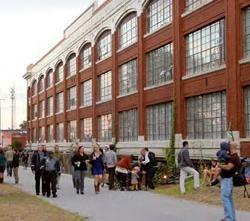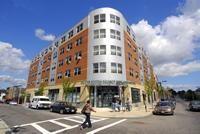Smart Growth, Brownfields, and Infill Development
Background
A brownfield is a property, the expansion, redevelopment, or reuse of which could be complicated by the presence or potential presence of a hazardous substance, pollutant, or contaminant. Cleaning up and redeveloping these properties can remove contaminants that harm air and water quality, reduce blight, and take development pressure off green spaces and working lands.
- Brownfield redevelopment can transform abandoned and underused sites into community and economic assets such as parks and plazas, mixed-use developments, and homes. Brownfield properties are often centrally located in areas where infrastructure is already available, which can make them valuable properties for development.
- Development and infrastructure policies influence the ease and cost of redeveloping brownfield properties. Smart growth land use strategies can make redevelopment more cost effective by allowing brownfield properties to redevelop with a mix of uses or encouraging more efficient land use. Directing infrastructure spending to roads and water and sewer lines on brownfield properties can also make these sites more attractive to developers.
- Brownfield sites are often in infill locations with existing transportation and utility infrastructure. Redevelopment in infill locations can use vacant buildings, parking lots, or other underused sites for new amenities, homes, and businesses near existing neighborhoods. When infill development occurs near transit or employment centers, it can reduce the distance people need to drive and give them other transportation options.
EPA Resources
Office of Community Revitalization
Publications
- City Green: Innovative Green Infrastructure Solutions for Downtowns and Infill Locations (2016): Case studies of projects around the country that illustrate how green infrastructure techniques can be used on sites that have limited space and other constraints to bring environmental and community benefits.
- Attracting Infill Development in Distressed Communities: 30 Strategies (2015): Helps communities determine their readiness to pursue infill development and identify strategies to better position themselves to attract infill development.
- Smart Growth and Economic Success: Investing in Infill Development (2014): Discusses how barriers to infill development that discourage developers are not only often surmountable, but also are diminishing as infill development becomes more common.
- Equitable Redevelopment of Petroleum Brownfields for Zuni Pueblo and Other Tribal Communities (2013): Step-by-step guide to help tribes overcome policy and other barriers to redevelopment of contaminated and vacant sites. (This publication is available in the EPA Archive. Click on SEARCH EPA ARCHIVE and type or copy and paste the title into the search box.)
- Residential Construction Trends in America's Metropolitan Regions (2012, 2010, and 2009): Analyzes residential building trends to determine if there has been a shift toward redevelopment and in which regions the shift has been most significant. (This publication is available in the EPA Archive. Click on SEARCH EPA ARCHIVE and type or copy and paste the title into the search box.)
- Restructuring the Commercial Strip: A Practical Guide for Planning the Revitalization of Deteriorating Strip Corridors (2010): Provides guidance on coordination of public and private investments and essential planning and design strategies to create a multimodal transportation system and thriving neighborhoods. (This publication is available in the EPA Archive. Click on SEARCH EPA ARCHIVE and type or copy and paste the title into the search box.)
- Measuring the Air Quality and Transportation Impacts of Infill Development (2007): Illustrates how regions can calculate the transportation and air quality benefits of infill, based on standard transportation forecasting models used by metropolitan planning organizations across the country.
National Award for Smart Growth Achievement
The National Award for Smart Growth Achievement recognizes exemplary smart growth projects across the country. Many of the winning projects included cleanup and redevelopment of brownfield sites.
 Historic Fourth Ward Park and the Atlanta BeltLine have helped to spark over $775 million in private development, including the mixed-use redevelopment of the long-abandoned Sears Warehouse Building. Photo courtesy of Christopher T. Martin
Historic Fourth Ward Park and the Atlanta BeltLine have helped to spark over $775 million in private development, including the mixed-use redevelopment of the long-abandoned Sears Warehouse Building. Photo courtesy of Christopher T. Martin
- Atlanta BeltLine Eastside Trail and Historic Fourth Ward Park – Atlanta, Georgia (2013): The park and trail, which had high levels of contamination that had to be cleaned up before development could begin, are sparking economic development, community engagement, and new affordable housing options in nearby neighborhoods. Watch the video Exit.
- La Valentina – Sacramento, California (2013): An energy-efficient, mixed-income, mixed-use apartment building on a former brownfield site next to a light-rail station is transforming an industrial area and giving residents transportation options. Watch the video Exit.
- Larkin District – Buffalo, New York (Honorable Mention 2012): Revitalization of Buffalo’s Hydraulics District sparked brownfields cleanup and redevelopment.
- Plan El Paso – El Paso, Texas (2011): With robust community input, Plan El Paso 2010 created a vision for three environmentally sustainable, transit-oriented neighborhoods linked by bus rapid transit and anchored by the redevelopment of a 600-acre, former industrial brownfield site. Watch the video Exit.
- Silver Gardens – Albuquerque, New Mexico (2011): Silver Gardens Apartments is a 66-unit, highly energy-efficient affordable housing development located on a reclaimed brownfield site in downtown Albuquerque near the city's primary transit hub. Watch the video Exit.
- Mission Creek Senior Community – San Francisco, California (2008): Mission Creek transformed a brownfield into an attractive, mixed-use, low-income senior community.
 The once-contaminated auto-body shop now provides a commercial and residential anchor for the neighborhood. Photo courtesy of Egleston Crossing.
The once-contaminated auto-body shop now provides a commercial and residential anchor for the neighborhood. Photo courtesy of Egleston Crossing. - Egleston Crossing – Roxbury, Massachusetts (2008): Two underused parcels of land, including a former garage with a history of environmental contamination, were cleaned up and now house new, green, mixed-use structures.
- Bethel Center – Chicago, Illinois (2006): Bethel Center, which catalyzed transit-oriented redevelopment in the West Garfield Park neighborhood, provides employment services, child care, and banking in a green building on a former brownfield.
- Old Town Wichita – Wichita, Kansas (2006): Wichita's largest environmental cleanup effort spurred redevelopment in the city’s former warehouse district, now known as Old Town, bringing new homes and businesses to the historic neighborhood.
- Livable Communities Program – Minneapolis-St. Paul Metropolitan Area, Minnesota (2003): The Livable Communities Program gives financial and technical support to public entities and their private-sector partners to redevelop brownfield sites, produce affordable housing, and create or revitalize town centers and neighborhoods.
- Wellington Neighborhood – Breckenridge, Colorado (2002): The Wellington Neighborhood provides affordable and market-rate housing on a cleaned-up site that was once dredge-mined. The project recycles land, creates housing for working families, and provides a free transit shuttle to the nearby downtown.
Brownfields and Land Revitalization Programs
EPA’s Brownfields Program provides grants and technical assistance to communities, states, tribes, and other stakeholders, giving them the resources they need to prevent, assess, safely clean up, and sustainably reuse brownfields. EPA’s Land Revitalization Program works with communities, states, nonprofits, and other stakeholders to develop and test sustainable approaches for the reuse of formerly contaminated properties.
Office of Environmental Justice
EPA’s Office of Environmental Justice facilitates the Agency’s efforts to protect the environment and public health in minority, low-income, tribal, and other vulnerable communities by integrating environmental justice in all programs, policies, and activities. Many of the office’s initiatives involve cleanup and redevelopment of brownfield sites.
Publications
- Pilot Framework for Integrating Community Health and Wellness into the Superfund Reuse Assessment Process (PDF) (46 pp, 13 MB, About PDF) (2014): Summarizes a pilot framework for integrating health, prevention, and wellness considerations during the Superfund reuse assessment process.
- Addressing Environmental Justice in Brownfields Communities (2009): Discusses the work of EPA’s Brownfields Program to promote environmental justice.
- Unintended Impacts of Redevelopment and Revitalization Efforts in Five Environmental Justice Communities (2006): Contains recommendations on avoiding the displacement that can follow successful brownfields cleanup and redevelopment.
- Environmental Justice, Urban Revitalization, and Brownfields: The Search for Authentic Signs of Hope (PDF) (85 pp, 322 K, About PDF) (1996): Provides recommendations based on a series of public hearings called "Public Dialogues on Urban Revitalization and Brownfields: Envisioning Health and Sustainable Communities," held in Boston, Philadelphia, Detroit, Oakland, and Atlanta in 1995.
Other Federal Resources
Green Pattern Book: Using Vacant Land to Create Greener Neighborhoods in Baltimore (2015): Publication developed by the U.S. Forest Service that offers clear guidance, including specific patterns for different types of sites, to help Baltimore green its vacant lots.
